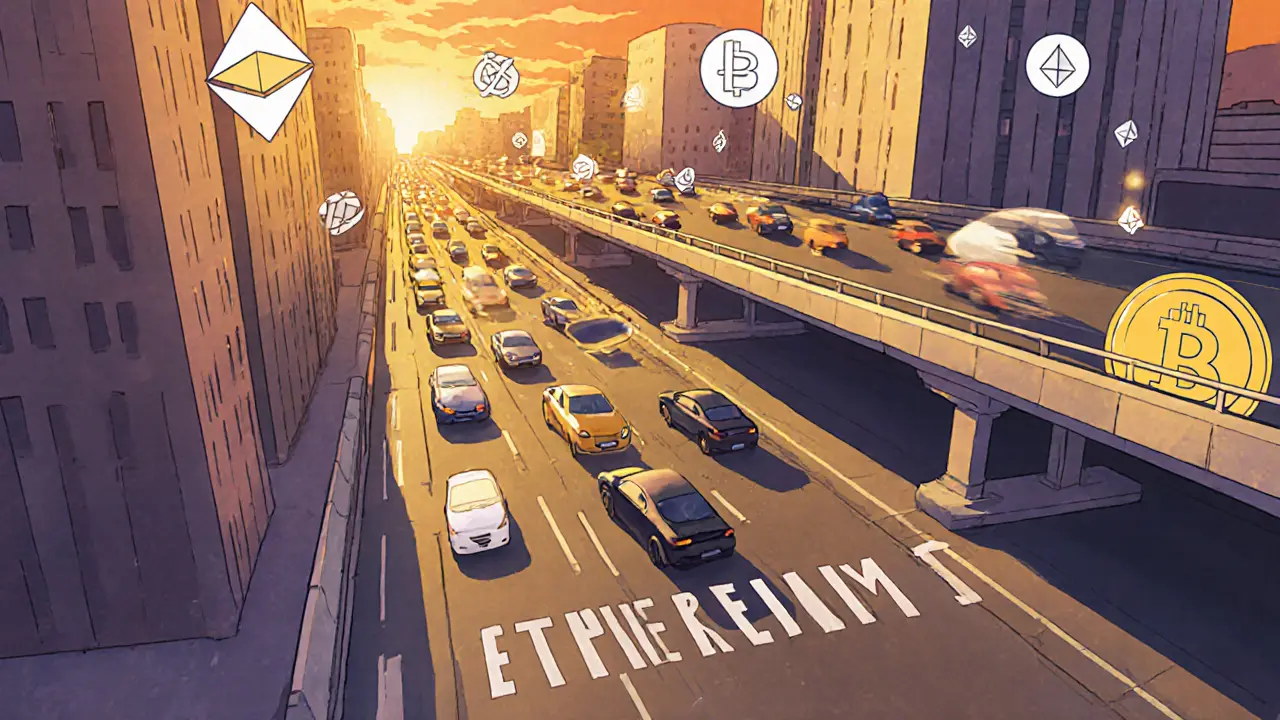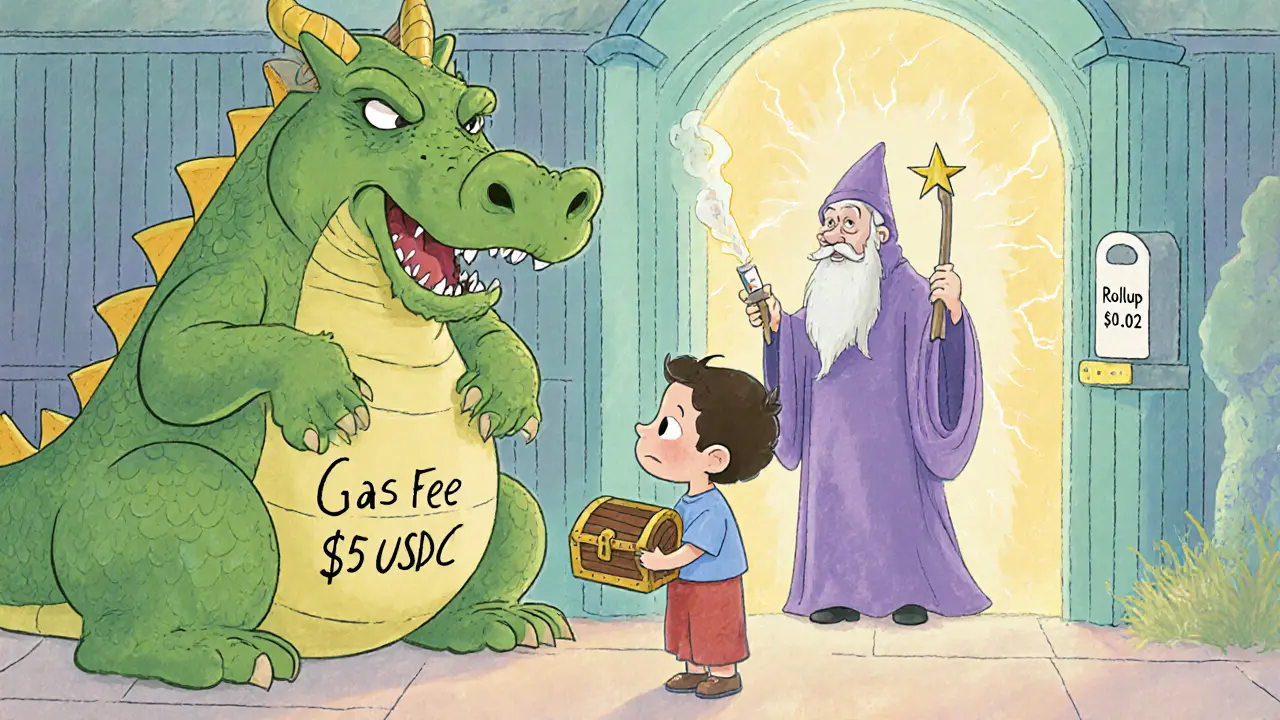Posted By Tristan Valehart On 14 Nov 2025 Comments (5)

Layer 2 Transaction Cost Calculator
Calculate Your Savings
See how much you pay on Ethereum Layer 1 versus Layer 2. Based on real-world fee data from the article.
Results
Think about the last time you tried to send ETH during a busy market day. You set your gas fee high, waited five minutes, and still got an error. Then you tried again - this time with a lower fee - and your transaction sat in limbo for over an hour. That’s not blockchain failing. That’s Layer 1 failing. And that’s why Layer 2 solutions aren’t just nice-to-have anymore - they’re the only reason blockchain can work for real people, not just speculators.
Why Layer 1 Can’t Keep Up
Ethereum, the most used blockchain for apps and DeFi, was never built to handle millions of daily transactions. It processes about 15 to 25 transactions per second. Compare that to Visa, which handles over 65,000 per second. Even Bitcoin, the original blockchain, maxes out at 7 TPS. When demand spikes - like during an NFT drop or a DeFi yield surge - the network gets clogged. Gas fees spike. Confirmations stall. Users get frustrated. This isn’t a bug. It’s a design trade-off. Ethereum prioritizes security and decentralization over speed. That’s great for storing value, but terrible for everyday use. That’s where Layer 2 comes in.What Layer 2 Actually Does
Layer 2 isn’t a separate blockchain. It’s a side highway built on top of Ethereum (or another Layer 1). Think of it like this: instead of every car driving through the city center (Layer 1), most cars take a toll road (Layer 2) that feeds back into the main road in batches. Transactions happen off-chain - instantly and cheaply - then get bundled into one single proof that’s posted back to Ethereum. This proof is verified by the main chain, so you keep all the security of Ethereum without the cost or delay. There are two main types:- Optimistic Rollups assume transactions are valid unless someone challenges them within a 7-day window. They’re faster to build and work with most existing Ethereum tools.
- zk-Rollups use mathematical proofs (zero-knowledge) to prove transactions are valid without revealing details. They’re faster to finalize and more secure, but harder to build.
Speed: From Minutes to Milliseconds
On Ethereum Layer 1, a simple transfer can take 15 seconds to 5 minutes. During congestion, it can take hours. On Layer 2, it’s different:- Polygon’s zkEVM confirms transactions in under 2 seconds.
- Arbitrum and OP Mainnet average 1-3 seconds per transaction.
- Immutable X handles NFT trades in under a second.
- Some specialized chains like zkSync and StarkNet hit sub-500ms confirmation times.

Costs: From Dollars to Cents
Here’s the real game-changer: cost. On Ethereum, sending ETH or swapping tokens during peak hours can cost $5 to $50. Sometimes more. For small transactions - like sending $20 worth of USDC - that’s insane. On Layer 2, it’s different:- Polygon: $0.001 to $0.01 per transaction
- Arbitrum: $0.005 to $0.03
- zkSync: $0.002 to $0.01
- Immutable X: $0.0005 for NFT minting
Real-World Use Cases That Only Work on Layer 2
Layer 1 can’t support these applications. Layer 2 makes them real:- Gaming: Players trade skins, buy loot boxes, and compete in real-time - all on-chain. On Ethereum, that would cost hundreds per session. On Polygon or Immutable X, it’s pennies.
- DeFi: Traders execute complex strategies - arbitrage, liquidations, multi-hop swaps - dozens of times a day. Layer 1 fees would eat 80% of profits. Layer 2 lets them keep 95%.
- Marketplaces: NFT platforms like OpenSea now default to Arbitrum and Polygon. Minting a single NFT on Ethereum used to cost $100+. Now it’s under $0.10.
- Payments: Apps like Strike and BitPay use Layer 2 to let users send crypto across borders with near-zero fees and instant settlement.

Choosing the Right Layer 2
Not all Layer 2s are the same. Here’s what to look for:| Network | Speed (Avg Confirm) | Cost per Tx | Security Model | Best For |
|---|---|---|---|---|
| Polygon zkEVM | 2 seconds | $0.001-$0.01 | zk-Rollup | DeFi, NFTs, general use |
| Arbitrum One | 1-3 seconds | $0.005-$0.03 | Optimistic Rollup | DeFi, dApps, Ethereum compatibility |
| OP Mainnet | 1-3 seconds | $0.005-$0.02 | Optimistic Rollup | High-volume apps, social tokens |
| zkSync Era | 0.5 seconds | $0.002-$0.01 | zk-Rollup | High-frequency trading, privacy-focused apps |
| Immutable X | 0.3 seconds | $0.0005 | zk-Rollup (NFT-specific) | NFT minting, gaming |
What’s Next for Layer 2
The next wave isn’t just about being faster. It’s about being invisible. Developers are working on:- Cross-chain bridges that let you move assets between Layer 2s without going back to Ethereum.
- Account abstraction that lets users pay gas in any token - even USDC - not just ETH.
- Modular blockchains where Layer 2s can pick their own consensus, data availability, or security layer.
Why This Matters for You
If you’re holding crypto, trading, or using DeFi - you’re already using Layer 2. Even if you don’t realize it. Most wallets like MetaMask now auto-route you to Arbitrum or Polygon because they’re smarter than letting you pay $20 in gas to swap $50. Ignoring Layer 2 means paying more, waiting longer, and missing out. It’s like using dial-up internet in 2025. You can technically do it. But why would you? The future of blockchain isn’t on Ethereum’s main chain. It’s on the layers built on top of it. And those layers are already here.Are Layer 2 solutions safe?
Yes - but it depends on the type. zk-Rollups are considered more secure because they use cryptographic proofs that are verified immediately. Optimistic Rollups rely on a 7-day challenge period, which means there’s a small window where fraud could theoretically go undetected. But in practice, both are backed by Ethereum’s security, and no major exploit has ever compromised funds on a top Layer 2 like Arbitrum or Polygon. Always use well-established networks and avoid unknown Layer 2s.
Do I need to switch wallets to use Layer 2?
No. Most wallets like MetaMask, Phantom, or Trust Wallet support multiple Layer 2s. You just need to add the network manually or use the built-in network switcher. Your private keys stay the same - you’re just connecting to a different chain. Some wallets even auto-detect which Layer 2 is cheapest and route your transaction there.
Can I move assets from Layer 1 to Layer 2?
Yes, and it’s simple. In your wallet, select the Layer 2 network (like Arbitrum or Polygon), then click "Bridge" or "Deposit." You’ll send ETH or tokens from Ethereum to the Layer 2. The process takes 5-20 minutes and costs a small fee - usually under $1. Once on Layer 2, you can trade, stake, or swap with near-zero fees.
Is Layer 2 better than other blockchains like Solana or Avalanche?
It’s not a competition - it’s a complement. Solana and Avalanche are Layer 1s with fast speeds and low fees built in. But they’re not as decentralized or secure as Ethereum. Layer 2s like Arbitrum and Polygon keep Ethereum’s security while adding speed. If you care about decentralization and long-term trust, Layer 2 on Ethereum is the safest bet. If you just want speed and don’t mind trusting a single validator set, Solana might be faster - but riskier.
Will Layer 2 make Ethereum gas fees go down permanently?
Yes - but not because Ethereum got faster. It’s because most activity moved off-chain. Ethereum’s base layer will always be expensive because it’s designed for security, not throughput. Layer 2s handle the volume. That’s why Ethereum’s gas fees have dropped 90% since 2022 - not because of upgrades, but because users and apps moved to Layer 2. This is the permanent solution.


Katherine Wagner
November 14, 2025 AT 16:11Hannah Kleyn
November 15, 2025 AT 13:12Byron Kelleher
November 16, 2025 AT 05:38Kelly McSwiggan
November 16, 2025 AT 16:38ratheesh chandran
November 18, 2025 AT 01:52